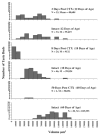Chorda tympani nerve transection at different developmental ages produces differential effects on taste bud volume and papillae morphology in the rat
- PMID: 15898061
- PMCID: PMC4965235
- DOI: 10.1002/neu.20140
Chorda tympani nerve transection at different developmental ages produces differential effects on taste bud volume and papillae morphology in the rat
Abstract
Chorda tympani nerve transection (CTX) results in morphological changes to fungiform papillae and associated taste buds. When transection occurs during neonatal development in the rat, the effects on fungiform taste bud and papillae structure are markedly more severe than observed following a comparable surgery in the adult rat. The present study examined the potential "sensitive period" for morphological modifications to tongue epithelium following CTX. Rats received unilateral transection at 65, 30, 25, 20, 15, 10, or 5 days of age. With each descending age at the time of transection, the effects on the structural integrity of fungiform papillae were more severe. Significant losses in total number of taste buds and filiform-like papillae were observed when transection occurred 5-30 days of age. Significant reduction in the number of taste pores was indicated at every age of transection. Another group of rats received chorda tympani transection at 10, 25, or 65 days of age to determine if the time course of taste bud degeneration differed depending on the age of the rat at the time of transection. Taste bud volumes differed significantly from intact sides of the tongue at 2, 8, and 50 days post-transection after CTX at 65 days of age. Volume measurements did not differ 2 days post-transection after CTX at 10 or 25 days of age, but were significantly reduced at the other time points. Findings demonstrate a transitional period throughout development wherein fungiform papillae are highly dependent upon the chorda tympani for maintenance of morphological integrity.
Figures






Similar articles
-
Neonatal chorda tympani transection permanently disrupts fungiform taste bud and papilla structure in the rat.Physiol Behav. 2000 Jun 1-15;69(4-5):439-44. doi: 10.1016/s0031-9384(99)00259-0. Physiol Behav. 2000. PMID: 10913782
-
Time course of morphological alterations of fungiform papillae and taste buds following chorda tympani transection in neonatal rats.J Neurobiol. 2002 Jun 5;51(3):223-36. doi: 10.1002/neu.10055. J Neurobiol. 2002. PMID: 11984844 Free PMC article.
-
Fungiform taste bud degeneration in C57BL/6J mice following chorda-lingual nerve transection.J Comp Neurol. 2007 Sep 10;504(2):206-16. doi: 10.1002/cne.21436. J Comp Neurol. 2007. PMID: 17626272 Free PMC article.
-
Regeneration of fungiform taste buds: temporal and spatial characteristics.J Comp Neurol. 1977 Apr 15;172(4):609-26. doi: 10.1002/cne.901720405. J Comp Neurol. 1977. PMID: 838892
-
Morphology of chorda tympani fiber receptive fields and proposed neural rearrangements during development.J Neurosci. 1988 Jan;8(1):73-8. doi: 10.1523/JNEUROSCI.08-01-00073.1988. J Neurosci. 1988. PMID: 3339420 Free PMC article.
Cited by
-
Factors that regulate embryonic gustatory development.BMC Neurosci. 2007 Sep 18;8 Suppl 3(Suppl 3):S4. doi: 10.1186/1471-2202-8-S3-S4. BMC Neurosci. 2007. PMID: 17903280 Free PMC article. Review.
-
Refinement of innervation accuracy following initial targeting of peripheral gustatory fibers.J Neurobiol. 2006 Sep 1;66(10):1033-43. doi: 10.1002/neu.20289. J Neurobiol. 2006. PMID: 16838366 Free PMC article.
-
Chronic Oral Capsaicin Exposure During Development Leads to Adult Rats with Reduced Taste Bud Volumes.Chemosens Percept. 2016 Sep;9(3):95-104. doi: 10.1007/s12078-016-9214-2. Epub 2016 Jul 30. Chemosens Percept. 2016. PMID: 28083080 Free PMC article.
-
Microglia density decreases in the rat rostral nucleus of the solitary tract across development and increases in an age-dependent manner following denervation.Neuroscience. 2017 Jul 4;355:36-48. doi: 10.1016/j.neuroscience.2017.04.037. Epub 2017 May 4. Neuroscience. 2017. PMID: 28478126 Free PMC article.
-
Chorda tympani nerve terminal field maturation and maintenance is severely altered following changes to gustatory nerve input to the nucleus of the solitary tract.J Neurosci. 2011 May 25;31(21):7591-603. doi: 10.1523/JNEUROSCI.0151-11.2011. J Neurosci. 2011. PMID: 21613473 Free PMC article.
References
-
- Calia E, Persico AM, Baldi A, Keller F. BDNF and NT-3 applied in the whisker pad reverse cortical changes after peripheral deafferentation in neonatal rats. Eur J Neurosci. 1998;10:3194–3200. - PubMed
-
- Fiske BK, Brunjes PC. Cell death in the developing and sensory-deprived rat olfactory bulb. J Comp Neurol. 2001;431:311–319. - PubMed
-
- Ganchrow JR, Ganchrow D. Long-term effects of gustatory neurectomy on fungiform papillae in the young rat. Anat Rec. 1989;225:224–231. - PubMed
-
- Ganchrow D, Ganchrow JR, Verdin-Alcazar M, Whitehead MC. Brain-derived neurotrophic factor-, neurotrophin-3-, and tyrosine kinase receptor-like immunoreactivity in lingual taste bud fields of mature hamster after sensory denervation. J Comp Neurol. 2003;455:25–39. - PubMed
-
- Harada S, Yamaguchi K, Kanemaru N, Kasahara Y. Maturation of taste buds on the soft palate of the postnatal rat. Physiol Behav. 2000;68:333–339. - PubMed
Publication types
MeSH terms
Grants and funding
LinkOut - more resources
Full Text Sources

